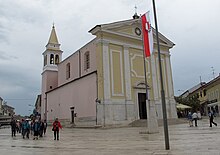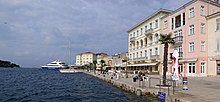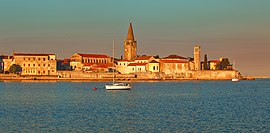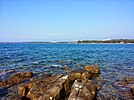Poreč
Poreč
Parenzo Parenso | |
|---|---|
| City of Poreč Grad Poreč Città di Parenzo[1] | |
Poreč | |
| Coordinates:45°13′38″N13°35′45″E/ 45.22722°N 13.59583°E | |
| Country | |
| County | |
| Government | |
| • Mayor | Loris Peršurić[2](IDS) |
| • City Council | 17 members |
| Area | |
| •City | 111.7 km2(43.1 sq mi) |
| • Urban | 14.3 km2(5.5 sq mi) |
| Elevation | 29 m (95 ft) |
| Population (2021)[4] | |
| •City | 16,607 |
| • Density | 150/km2(390/sq mi) |
| •Urban | 8,841 |
| • Urban density | 620/km2(1,600/sq mi) |
| Time zone | UTC+1(CET) |
| • Summer (DST) | UTC+2(CEST) |
| Postal code | 52 440 |
| Area code | 052 |
| Website | porec |
Poreč(Croatian pronunciation:[ˈpɔrɛtʃ];Italian:Parenzo;Venetian:Parenso;Latin:ParensorParentium;Ancient Greek:Πάρενθος,romanized:Párenthos) is a town and municipality on the western coast of theIstrian peninsula,inIstria County,westCroatia.Its major landmark is the 6th-centuryEuphrasian Basilica,which was designated aUNESCOWorld Heritage Sitein 1997.[5]
The town is almost 2,000 years old, and is set around aharbourprotected from the sea by the smallislandof Sveti Nikola/San Nicola (Saint Nicholas). Its population of approximately 12,000 resides mostly on the outskirts, while the wider Poreč area has a population of approximately 16,600 inhabitants. The municipal area covers 142 square kilometres (55 sq mi), with the 37 kilometres (23 miles) long shoreline stretching from theMirna RivernearNovigrad(Cittanova) toFuntana(Fontane) andVrsar(Orsera) in the south. Ever since the 1970s, the coast of Poreč and neighboringRovinj(Rovigno) has been the most visited tourist destination in Croatia.[citation needed]
History
[edit]

Roman period
[edit]During the 2nd century BC, a Romancastrumwas built on a tinypeninsulawith approximate dimensions of 400 m × 200 m (1,312.34ft× 656.17 ft) where the town centre is now. During the reign ofEmperorAugustusin the 1st century BC, it officially became acityand was part of the RomancolonyofColonia Iulia Parentium.
In the 3rd century the settlement had an organisedChristiancommunity with an early-Christian complex of sacral buildings. The earliestbasilicacontained the remains of and was dedicated toSaint Maurus of Parentiumand dates back to the second half of the 4th century. The floor mosaic from itsoratory,originally part of a large Roman house, is still preserved in the garden of theEuphrasian Basilica.
Middle Ages
[edit]With the fall of theWestern Roman Empirein 476, different rulers and powers governed. First, it was held by theOstrogothsand after 539 was part of theByzantine Empire.From 788 it was ruled by theFranks.A short independence period followed in the 12th century and later it was ruled by thePatriarchate of Aquileia.In 1267 Parenzo became the first Istrian city that chose to become part of theRepublic of Venice,whose rule lasted for more than five centuries. During this period several palaces, squares and religious buildings in Venetian style were built. In 1354 the city was destroyed by theGenoese.In 1363 the town was given the City Statute.
Modern period
[edit]The population was decimated byplagueat the end of the 16th and the beginning of the 17th century. After thefall of the Venetian Republic,Parenzo came under the sovereignty of theHabsburg monarchy.
Between 1805 and 1814, Parenzo was part of the NapoleonicKingdom of Italyand then of theIllyrian Provinces,nominally part of theFirst French Empire.After this period it was again annexed by theHabsburgs,with the Monarchy reorganized into theAustrian Empire.In 1844 a steamship connection was established between Parenzo andTrieste.
In 1861, underAustrian LittoralParenzo became the seat of the regional Parliament,[citation needed]with schools, administrative and judiciary offices, and other services. During this time, it slowly became a shipbuilding center. It also became a popular tourist resort for theAustro-Hungarianaristocracy. Between 1902 and 1935 theParenzana(from the name 'Parenzaner Bahn'), a narrow-gauge railway line connected the town toTrieste.
After 1918, it became part of theKingdom of Italy.In 1944, the city wasbombedby theAllies34 times, damaging 75% of the city.[6]
Yugoslav period (1945/47-1991)
[edit]In 1947, two years afterWorld War II,it was occupied by Yugoslavia and the city name was changed intoPoreč.The Italian populationleft the cityand was replaced by Slavic people from different regions of Yugoslavia.[7]
From 1945 to 1991, Poreč was a city ofCroatia,then part of theSocialist Federal Republic of Yugoslavia.
Independent Croatia (since 1991)
[edit]In 1991Croatiabecame an independent state. Today, the city'sItalianname (Parenzo) is also used in an official capacity.[8][9]
Climate
[edit]
Situated on the western coast of Istria and cooled by sea breezes, the localclimateis relatively mild and free of oppressive summer heat. The month of July is the hottest, with a maximum air temperature of30°Cin conditions of lowhumidity,while January is the coldest with anaverageof 6 °C (43 °F). There are more than 2,400 hours of sun a year, an average of more than 10 hours of sunshine during the summer days. Sea temperatures can reach 28 °C (82 °F), higher than one might expect compared to the coast of southern Croatia where the air temperatures are higher. The average annualrainfallof 920 mm (36.2 in) is more or less equally distributed throughout the year, although July and August are very dry.[10]Winds here are theBora,bringing the cold, clear weather from the north in the winter, and theJugo,a warm southern wind bringing rain. The summer breeze that blows from the sea to the land is called theMaestral.
Nearby sightseeing sites
[edit]
TheBaredine Cave,the only open geologicalmonumentin Istria, is in the vicinity. Stalagmites in the cave are known for their curious shapes. One is said to resemble theVirgin Mary,another theLeaning Tower of Pisa.[11]
Lim Bayis a 12-km longestuarywith the aspect of a narrow canal, created by the riverPazinčicaby eroding the ground on its way to theAdriatic Sea.Quartzboulders are occasionally found here, exposed by the sea.
Vegetation and agriculture
[edit]The landscape is rich inMediterraneanvegetation,withpinewoods and green bushes, mostly of theholm oakandstrawberry tree.For generations, the fertileblood-red land (crljenica) has been used foragriculture,withcereals,orchards,olivegroves andvegetablesthe main crops. Today the production of organic food is significant, includingolives,grapes,and popular wines such asMalvazija,Borgonja,Merlot,Pinot,Cabernet SauvignonandTeran.
Transportation
[edit]
Road traffic is the primary form of transportation. Poreč is well-connected with the rest of Istria and with larger cities such asTrieste,Rijeka(Fiume),LjubljanaandZagreb.The nearest commercialairportis inPula(Pola). Seatrafficis less important today than it was in previous centuries; these days it is primarily used for tourist excursions. The closestrailwaystation is inPazin(Pisino), which is the seat of theIstria Countylocal authority.Between 1902 and 1937 theParenzana,a narrow-gauge railway line connected the town to Trieste.
Economy
[edit]

Traditionally, economic activities have always been connected with the land and sea. The only significant industry in the area isfood processing,but Croatia's ongoing integration into the broader European economy has led to Poreč seeing growth in itstrade,financeand communication sectors. However, the primary source ofincomeistourism.[12]
Real estateprices are very high due to the city's prime location.
Demographics
[edit]| Year | Pop. | ±% |
|---|---|---|
| 1880 | 7,355 | — |
| 1890 | 8,478 | +15.3% |
| 1900 | 10,168 | +19.9% |
| 1910 | 12,439 | +22.3% |
| 1921 | 12,252 | −1.5% |
| 1931 | 12,607 | +2.9% |
| 1948 | 9,862 | −21.8% |
| 1953 | 8,604 | −12.8% |
| 1961 | 8,216 | −4.5% |
| 1971 | 8,820 | +7.4% |
| 1981 | 11,739 | +33.1% |
| 1991 | 14,633 | +24.7% |
| 2001 | 17,460 | +19.3% |
| 2011 | 16,696 | −4.4% |
| Source: Naselja i stanovništvo Republike Hrvatske 1857–2001, DZS, Zagreb, 2005 | ||
According to the 2011 census, the main ethnic groups in Poreč areCroats(74.8%),Istrian Italians(3.2%),Serbs(3.4%),Albanians(2.7%) andBosniaks(1.95%).[13] Also part of the Parentian people submitted the choice "regional" (asIstrian), regardless of their Italian or Croatian origin. In the common use Italian is spoken by 15% of the local population.
According to the 2011 census, there are 9,790 residents of the town of Poreč, and with allsettlementsincluded, municipality of Poreč has a total of 16,696 residents:[14]
- Antonci,population 164
- Baderna,population 240
- Banki,population 17
- Bašarinka,population 90
- Blagdanići,population 15
- Bonaci,population 104
- Bratovići,population 19
- Brčići,population 163
- Buići,population 131
- Cancini,population 158
- Červar-Porat,population 527
- Črvar,population 99
- Čuši,population 20
- Dekovići,population 45
- Dračevac,population 166
- Filipini,population 43
- Fuškulin,population 181
- Garbina,population 68
- Jakići Gorinji,population 18
- Jasenovica,population 50
- Jehnići,population 39
- Jurići,population 3
- Kadumi,population 216
- Katun,population 64
- Kirmenjak,population 48
- Kosinožići,population 99
- Kukci,population 500
- Ladrovići,population 86
- Matulini,population 16
- Mičetići,population 37
- Mihatovići,population 122
- Mihelići,population 43
- Montižana,population 57
- Mugeba,population 180
- Mušalež,population 366
- Nova Vas,population 480
- Poreč - Parenzo,population 9,790
- Radmani,population 241
- Radoši kod Žbandaja,population 115
- Rakovci,population 26
- Rupeni,population 2
- Ružići,population 19
- Stancija Vodopija,population 116
- Starići,population 8
- Stranići kod Nove Vasi,population 177
- Šeraje,population 2
- Štifanići,population 61
- Šušnjići,population 29
- Valkarin,population 44
- Veleniki,population 107
- Vrvari,population 792
- Vržnaveri,population 76
- Žbandaj,population 417
| population | 5748 | 6333 | 7355 | 8478 | 10168 | 12439 | 12252 | 12607 | 9862 | 8604 | 8216 | 8820 | 11739 | 14633 | 17460 | 16696 | 16607 |
| 1857 | 1869 | 1880 | 1890 | 1900 | 1910 | 1921 | 1931 | 1948 | 1953 | 1961 | 1971 | 1981 | 1991 | 2001 | 2011 | 2021 |

Main sights
[edit]The town plan still shows theancient RomanCastrumstructure.The main streets areDecumanusandCardo Maximus,still preserved in their original forms.Maraforis a Romansquarewith two temples attached. One of them, erected in the first centuryAD,is dedicated to theRoman godNeptune;its dimensions are 30 by 11 m (98.43 by 36.09ft). A few houses from theRomanesqueperiod have been preserved and beautiful Venetian Gothic palaces can be seen here. Originally aGothicFranciscanchurchbuilt in the 13th century, the 'Dieta Istriana' hall was remodeled in theBaroquestyle in the 18th century.
TheEuphrasian Basilica,rebuilt in the 6th century under theByzantine EmpireandbishopEuphrasius, is the most important historical site in Parenzo. It is a protectedWorld Heritage Site,so designated byUNESCOin 1997. Between the 12th and 19th centuries, the city haddefensive walls,as the better-knownDubrovnikstill does today.
Porec also has one of the smallest streets in Europe the Ulica Stjepana Konzula Istranina.
Tourism
[edit]

In 1844, theAustrian Lloydsteamship company opened atouristline which called at Parenzo. The first touristguidedescribing and depicting the town was printed as early as 1845. The oldesthotelis the Riviera, constructed in 1910. Later came the Parentino and others.
Today,touristinfrastructure is intentionally dispersed along the 37 km (23 mi) longcoastline,between theMirna Riverand the deepLim valley.The south hosts self-contained centres likePlava Laguna( "Blue Lagoon" ), Zelena Laguna ( "Green Lagoon" ), Bijela Uvala ( "White Cove" ) and Brulo. To the north, mirroring centres are Materada, Červar Porat, Ulika and Lanterna. In the high season, the area's temporary population can exceed 120,000.
Poreč'sheritagecan be seen in the historic town centre, inmuseumsand galleries hosted in houses and palaces, many of them still private homes as they have been for centuries. In the off season, weekend visitors fromCroatia,Slovenia,AustriaandItalyvisit the area. Sports complexes are developed and used year-round.
Notable natives
[edit]Chronologically:
- Giuseppe Picciola,Italian poet (1859–1907)
- Giuseppe Pagano,Italian architect (1896–1945)
- Mario Visintini(1913–1941), Italian flying ace of the Spanish Civil War and World War II
- Licio Visintini(1915–1942), brother of Mario, Italian naval officer during World War II, member of an elite commando frogman unit
- Rita Rusić(1960), Italian actress, singer and producer
- Simon Sluga(1993), Croatian footballer
Twin town and sister cities
[edit]See also
[edit]References
[edit]- ^The official site,see alsothe amendments to the Statute
- ^"Grad Poreč - Gradonačelnik".
- ^Register of spatial units of the State Geodetic Administration of the Republic of Croatia.WikidataQ119585703.
- ^"Population by Age and Sex, by Settlements"(xlsx).Census of Population, Households and Dwellings in 2021.Zagreb:Croatian Bureau of Statistics.2022.
- ^"Episcopal Complex of the Euphrasian Basilica in the Historic Centre of Poreč".
- ^[Tragom povijesti gradske knjižnice Poreč]
- ^Perselli, G. (2001).I censimenti della popolazione dell'Istria, con Fiume e Trieste, e di alcune città della Dalmazia tra il 1850 e il 1936.Unione Italiana-Fiume, Università Popolare-Trieste, Centro di Ricerche Storiche di Rovigno, Trieste-Rovigno.
- ^The official site of the City of Poreč, Grad Poreč – Città di Parenzo:http://www.porec.hr/prva.aspx?j=cro
- ^The document stating the official bilingual name of Poreč:http://www.istra-istria.hr/fileadmin/dokumenti/novosti/sjednice_skupstine_2005/21/21-04.pdfp.3.
- ^"Poreč".Archived fromthe originalon 2008-08-05.Retrieved2008-07-30.
- ^"Cave Baredine".Archived fromthe originalon 2009-03-01.Retrieved2008-07-30.
- ^"SAS Output".
- ^"Population by Ethnicity, by Towns/Municipalities, 2011 Census: County of Istria".Census of Population, Households and Dwellings 2011.Zagreb:Croatian Bureau of Statistics.December 2012.
- ^"Population by Age and Sex, by Settlements, 2011 Census: Poreč".Census of Population, Households and Dwellings 2011.Zagreb:Croatian Bureau of Statistics.December 2012.
External links
[edit] Porečtravel guide from Wikivoyage
Porečtravel guide from Wikivoyage- Poreč – Croatian National Tourist Board Website
- Poreč-Parenzo Tourist Office Official Website
- Poreč – Istria Tourist Board Website
- Istra Music Festival - International Music Festival in Poreč
- Poreč on the Map– Poreč locations on the map with extended info and historical facts
- Giovanni Maria Cassini (1791)."Lo Stato Veneto da terra diviso nelle sue provincie, quarta parte che compren de porzioni del Dogado e dell' Istria".Rome: Calcografia camerale.(Map of Parenzo region).















